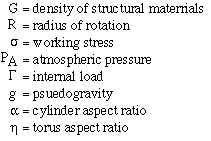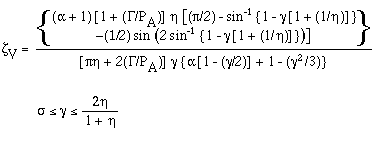TABLE 4-7.- STRUCTURAL MASSES




Structural mass is an important measure of the effort and resources required to build a habitat. To compare the masses required to construct different geometries two questions must be answered: How much mass is required to obtain a given amount of projected area? How much mass is needed to get a given habitable volume?
Formulas for the structural masses for several different geometries are given in table 4-7 both for stressed skin and for ribbed construction. It is convenient to represent the sphere as a limiting case of a cylinder with spherical endcaps.
TABLE 4-7 (gif format)
| Geometry | Stressed skin | Ribbed |
|---|---|---|
| Torus |  |
 |
| Cylinder with endcaps |  |
 |

To do this the aspect ratio,  = L/R, is
defined. It is also convenient to express the minor radius of the
torus in terms of an aspect ratio
= L/R, is
defined. It is also convenient to express the minor radius of the
torus in terms of an aspect ratio  .
.
Mass Per Projected Area or Per Habitable Volume for Different Geometries
From the formulas in tables 4-6 and 4-7, the mass required for a piece of projected area in a given geometry can be calculated. These tables also permit the mass per unit habitable volume to be determined.
It is convenient to compare different geometries by taking the ratio of their masses per projected area. The ratio of the mass per projected area for a cylinder with spherical endcaps to the mass per projected area for a torus (where for simplicity only stressed skin construction is considered) is given by:

which is independent of R and g and, therefore, of rotation rate.
Figure 4-19 is a graph of the
variation of this ratio for several configurations. Where  = 0, a torus and a sphere are compared; whereas for
= 0, a torus and a sphere are compared; whereas for
 = 10, the four models C-1 to C-4 discussed by
O'Neill (ref. 1) are compared to the corresponding toruses. In each
case the internal load is taken to be 0.16 of the pressure of the
atmosphere; the design figure in this study.
= 10, the four models C-1 to C-4 discussed by
O'Neill (ref. 1) are compared to the corresponding toruses. In each
case the internal load is taken to be 0.16 of the pressure of the
atmosphere; the design figure in this study.
From tables 4-6 and 4-7 an expression can be derived for the ratio of the mass per habitable volume of a cylinder with spherical endcaps to the mass per habitable volume of a torus.

where

|
Curator: Al Globus If you find any errors on this page contact Al Globus. |
 |
This site was hosted by the NASA Ames Research Center from 1994-2018 and is now hosted by:
